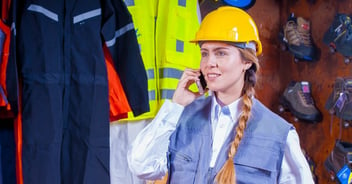Remote working can serve as a brilliant way to help people with disabilities and long-term health conditions to access the workforce. Unfortunately, disabled people are 28% less likely to be employed due in part to a lack of accommodations or difficulty in commuting.
With remote roles, people with disabilities don't have to commute, and they can have greater control over their working environment to ensure it suits their needs. However, employers are just as responsible for their remote employees' health and safety as on-site employees. Companies must take an active role in managing the security of remote disabled employees. Here are three things your organisation can do to help manage the safety of remote employees with disabilities stay safe.
1. Ask what they need
Every person with a disability faces unique challenges and barriers, and may require specific adjustments to make their workplace accessible and safe. With this in mind, be sure not to assume what an employee needs when working remotely. Ask them directly what adjustments they require and check in with them regularly to ensure your adjustments are still meeting their needs. Reasonable adjustments for disabled workers at home might include things like flexible working patterns, additional or modified equipment, or providing information in accessible formats.
2. Conduct regular risk assessments
Employers must assess health and safety risk to all employees, regardless of whether they work at home or at business premises. Consider the unique needs of each disabled employee to determine whether they can conduct a self-assessment or if it would be more appropriate for a health and safety officer to visit their workspace and conduct a full risk assessment.
The HSE recommends that risk assessments are reviewed regularly and always when new equipment or processes are implemented. For employees with disabilities or health issues, risk assessments may require additional reviews if the nature of their disability or condition changes. Employees are responsible for taking care of their health and safety to a certain extent, and part of this responsibility is to communicate with their manager about identified risks. Ensure you check in with employees regularly to allow them to report new hazards.
3. Keep in touch
All remote workers are at risk of stress and mental health issues associated with isolation. People with disabilities or physical health conditions are already more likely to experience mental health conditions, so disabled lone workers need plenty of social support. Managers or team leaders should regularly check in with remote workers via telephone or video meetings. Make sure that remote workers are updated on the latest events and developments in the organisation, so they feel involved. Hold virtual social events regularly to help remote colleagues connect and create a sense of community to minimise feelings of isolation.
Create an environment where employees feel safe to discuss disability
Key to keeping disabled employees safe, no matter if they work remotely or otherwise, is creating an atmosphere of support. Ensure that your goal is to provide necessary support so employees feel comfortable communicating their needs.





.webp?width=352&name=worker%20taking%20a%20rest%20(1).webp)
Leave a Comment